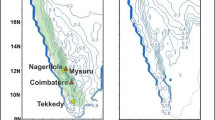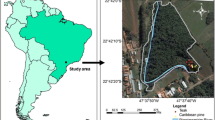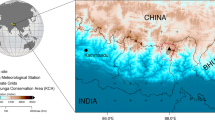Abstract
Indian monsoon (June–September) and post monsoon (October–November) rainfall show a distinct trend from coast to inland primarily due to moisture availability. However, the response of this synoptic-scale variation of rainfall amount to annual ring growth of Indian teak has not been studied systematically yet. The study is important as (1) ring width of Indian teak is considered as a reliable proxy for studying monsoon climate variability in multi-centennial time scale and (2) observed meteorological data show systematic changes in rainfall variation from coast to inland since last three decades. Towards this, we present here tree-ring width data from two locations—Thatibanda (1747–1979) and Nagzira (1728–2000) and use similar published data from two other locations—Allapalli (1866–1897) and Edugurapalli (1827–2000). The locations fall along a southeast northwest transect from south east Indian coast to inland. Monthly mean data from nearest observatories show an increasing trend in monsoon rainfall and a pronounced decreasing trend in post monsoon rainfall towards inland. Ring width data show moderately positive response to monsoon rainfall and negative response to summer (March–May) temperature for all stations suggesting moisture deficit in hot summer and intense precipitation in monsoon affect ring growth pattern in different ways. Ring width indices also exhibit significantly positive response with post monsoon rainfall at coastal location. The response gradually reduces towards inland. This preliminary study, thus, suggests that Indian teak has a potential to capture signals of the synoptic variation of post monsoon rainfall from coast to inland.




Similar content being viewed by others
References
Borgaonkar H, Pant G, Rupa Kumar K (1996) Ring-width variations in Cedrus deodara and its climatic response over the western Himalaya. Int J Climatol 16(12):1409–1422
Borgaonkar H, Sikder A, Ram S, Pant G (2010) El niño and related monsoon drought signals in 523-year-long ring width records of teak (Tectona grandis Lf) trees from South India. Palaeogeography, Palaeoclimatology, Palaeoecology 285(1):74–84
Braconnot P, Harrison SP, Kageyama M, Bartlein PJ, Masson-Delmotte V, Abe-Ouchi A, Otto-Bliesner B, Zhao Y (2012) Evaluation of climate models using palaeoclimatic data. Nat Clim Chang 2 (6):417–424
Buckley BM, Palakit K, Duangsathaporn K, Sanguantham P, Prasomsin P (2007) Decadal scale droughts over northwestern Thailand over the past 448 years: links to the tropical Pacific and Indian Ocean sectors. Clim Dyn 29(1):63–71
Champion SH, Seth SK et al (1968) A revised survey of the forest types of India. A revised survey of the forest types of India
Chang CP (2004) East Asian monsoon, vol 2. World Scientific, Singapore
Chowdhury KA (1940) The formation of growth rings in Indian trees. i, ii. Indian For Rec(NS) Utilization 1(2):1–39
Cook ER, Kairiukstis LA (2013) Methods of dendrochronology: applications in the environmental sciences. Springer Science & Business Media, Berlin
D’Arrigo R, Palmer J, Ummenhofer CC, Kyaw NN, Krusic P (2011) Three centuries of Myanmar monsoon climate variability inferred from teak tree rings. Geophys Res Lett 38:L24705. https://doi.org/10.1029/2011GL049927
Fritts H (2012) Tree rings and climate. Elsevier, Amsterdam
Goswami BN, Venugopal V, Sengupta D, Madhusoodanan M, Xavier PK (2006) Increasing trend of extreme rain events over India in a warming environment. Science 314(5804):1442–1445
Hegerl GC, Crowley TJ, Hyde WT, Frame DJ (2006) Climate sensitivity constrained by temperature reconstructions over the past seven centuries. Nature 440(7087):1029–1032
Holmes RL (1983) Computer-assisted quality control in tree-ring dating and measurement. Tree-Ring Bull 43 (1):69–78
Mall R, Singh R, Gupta A, Srinivasan G, Rathore L (2006) Impact of climate change on Indian agriculture: a review. Clim Chang 78(2-4):445–478
Moberg A, Sonechkin DM, Holmgren K, Datsenko NM, Karlén W (2005) Highly variable Northern Hemisphere temperatures reconstructed from low- and high-resolution proxy data. Nature 433(7026):613–617
Pant G, Kumar KR, Borgaonkar H, Okada N, Fujiwara T, Yamashita K (2000) Climatic response of Cedrus deodara tree-ring parameters from two sites in the western Himalaya. Can J For Res 30(7):1127–1135
Parthasarathy B, Munot A, Kothawale D (1994) All-India monthly and seasonal rainfall series: 1871–1993. Theor Appl Climatol 49(4):217–224
Pathak A, Ghosh S, Kumar P (2014) Precipitation recycling in the Indian subcontinent during summer monsoon. J Hydrometeorol 15(5):2050–2066
Ram S (2012) On the recent strengthening of the relationship between Palmer drought severity index and teak (Tectona grandis Lf) tree-ring width chronology from Maharashtra, India: a case study. Quat Int 248:92–97
Ram S, Borgaonkar H, Sikder A (2008) Tree-ring analysis of teak (Tectona grandis Lf) in Central India and its relationship with rainfall and moisture index. J Earth Syst Sci 117(5):637
Shah SK, Bhattacharyya A, Chaudhary V (2007) Reconstruction of June–September precipitation based on tree-ring data of teak (Tectona grandis L.) from Hoshangabad, Madhya Pradesh, India. Dendrochronologia 25 (1):57–64
Steinman BA, Abbott MB, Mann ME, Stansell ND, Finney BP (2012) 1,500 year quantitative reconstruction of winter precipitation in the Pacific northwest. Proc Natl Acad Sci 109(29):11,619–11,623
Stokes MA, Smiley TL (1968) An introduction to tree-ring dating. The University of Chicago Press, Chicago, 73
Wang B, Ding Q, Fu X, Kang I-S, Jin K, Shukla J, Doblas-Reyes F (2005) Fundamental challenge in simulation and prediction of summer monsoon rainfall. Geophys Res Lett 32:L15711. https://doi.org/10.1029/2005GL022734
Webster PJ, Magana VO, Palmer T, Shukla J, Tomas R, Yanai M, Yasunari T (1998) Monsoons: processes, predictability, and the prospects for prediction. J Geophys Res Oceans 103(C7):14,451–14,510
Wigley TM, Briffa KR, Jones PD (1984) On the average value of correlated time series, with applications in dendroclimatology and hydrometeorology. J Clim Appl Meteorol 23(2):201–213
Yadav RR, Singh J (2002) Tree-ring-based spring temperature patterns over the past four centuries in western Himalaya. Quat Res 57(3):299–305
Zhai P, Zhang X, Wan H, Pan X (2005) Trends in total precipitation and frequency of daily precipitation extremes over China. J Clim 18(7):1096–1108
Acknowledgements
The Indian Institute of Tropical Meteorology, Pune (IITM) is fully supported by the Earth System Science Organization (ESSO) of Ministry of Earth Sciences, India. Director of IITM and Dr. R. Krishnan, executive director, Centre for Climate Change Research, IITM, are acknowledged for their constant encouragement. We are also thankful to the Forest Departments of Maharashtra and Andhra Pradesh for their co-operation and help during the fieldwork and India Meteorological Department, Pune, for providing basic meteorological data. The work was supported by the Indian Space Research Organization-Geosphere Biosphere Programme (ISRO-GBP).
Author information
Authors and Affiliations
Corresponding author
Rights and permissions
About this article
Cite this article
Sengupta, S., Borgaonkar, H., Joy, R.M. et al. Monsoon climate response in Indian teak (Tectona grandis L.f.) along a transect from coast to inland. Theor Appl Climatol 134, 1197–1205 (2018). https://doi.org/10.1007/s00704-017-2334-z
Received:
Accepted:
Published:
Issue Date:
DOI: https://doi.org/10.1007/s00704-017-2334-z




